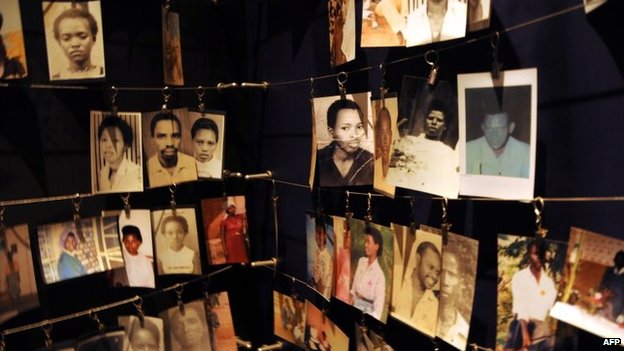In just 100 days in 1994, some 800,000 people were slaughtered in Rwanda by ethnic Hutu extremists. They were targeting members of the minority Tutsi community, as well as their political opponents, irrespective of their ethnic origin.
Why did the Hutu militias want to kill the Tutsis?
About 85% of Rwandans are Hutus but the Tutsi minority has long dominated the country. In 1959, the Hutus overthrew the Tutsi monarchy and tens of thousands of Tutsis fled to neighbouring countries, including Uganda. A group of Tutsi exiles formed a rebel group, the Rwandan Patriotic Front (RPF), which invaded Rwanda in 1990 and fighting continued until a 1993 peace deal was agreed.
On the night of 6 April 1994 a plane carrying then President Juvenal Habyarimana, and his counterpart Cyprien Ntaryamira of Burundi – both Hutus – was shot down. Hutu extremists blamed the RPF and immediately started a well-organised campaign of slaughter. The RPF said the plane had been shot down by Hutus to provide an excuse for the genocide.
100 days of slaughter
- 6 April 1994: President Habyarimana dies in plane crash
- 7 April: Rwandan armed forces and militia start killing of Tutsis and moderate Hutus
- 7 April: Tutsi Rwandan Patriotic Front (RPF) rebels resume offensive
- 11 April: Tens of thousands already dead – Red Cross
- 17 May: UN Security Council says acts of genocide have been committed, however no reinforcements sent
- 22 May: RPF controls Kigali airport
- 22 June: Killing of Tutsis continues in “safe” area despite presence of French troops
- 4 July: RPF controls Kigali
(Source: BBC News Africa)











 Inauguration ceremony of President of Azerbaijan Ilham Aliyev was held
Inauguration ceremony of President of Azerbaijan Ilham Aliyev was held Ilham Aliyev wins presidential election with 92.05 percent of votes VIDEO
Ilham Aliyev wins presidential election with 92.05 percent of votes VIDEO President Ilham Aliyev, First Lady Mehriban Aliyeva and family members voted in Khankendi VIDEO
President Ilham Aliyev, First Lady Mehriban Aliyeva and family members voted in Khankendi VIDEO Plenary session of 6th Summit of Conference on Interaction and Confidence Building Measures in Asia gets underway in Astana. President Ilham Aliyev attends the plenary session VIDEO
Plenary session of 6th Summit of Conference on Interaction and Confidence Building Measures in Asia gets underway in Astana. President Ilham Aliyev attends the plenary session VIDEO President Ilham Aliyev was interviewed by Azerbaijani TV channels in Prague VIDEO
President Ilham Aliyev was interviewed by Azerbaijani TV channels in Prague VIDEO














